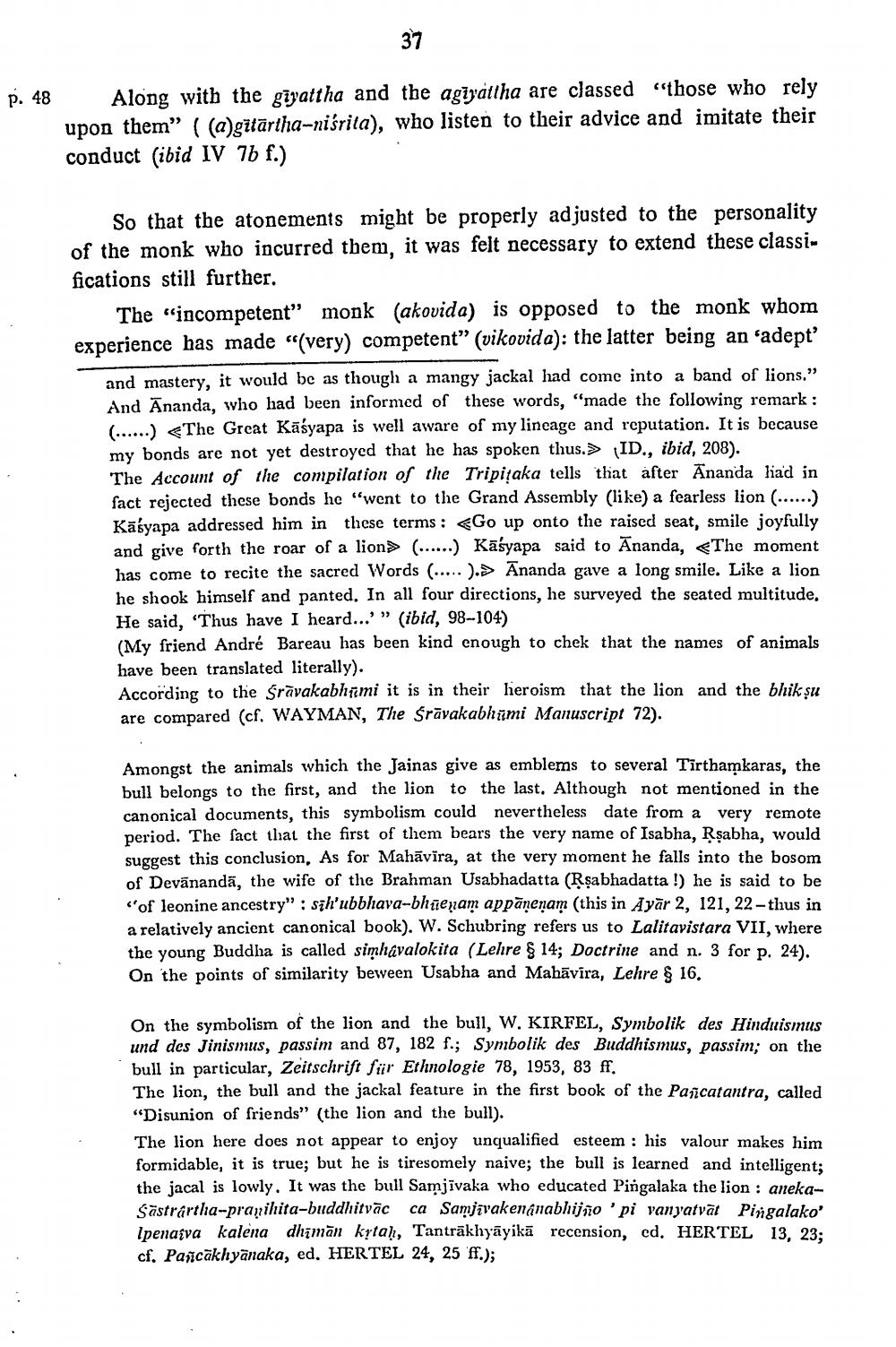________________
P. 48
Along with the giyattha and the agīyattha are classed those who rely upon them" ( (agitārtha-nisrila), who listen to their advice and imitate their conduct (ibid IV 7b f.)
So that the atonements might be properly adjusted to the personality of the monk who incurred them, it was felt necessary to extend these classifications still further
The "incompetent" monk (akovida) is opposed to the monk whom experience has made “(very) competent” (vikovida): the latter being an 'adept
and mastery, it would be as though a mangy jackal had come into a band of lions." And Ananda, who had been informed of these words, "made the following remark: (.....) The Great Kāśyapa is well aware of my lineage and reputation. It is because my bonds are not yet destroyed that he has spoken thus. > ID., ibid, 208). The Account of the compilation of the Tripițaka tells that after Ananda liad in fact rejected these bonds he went to the Grand Assembly (like) a fearless lion (.....) Kāsyapa addressed him in these terms: <Go up onto the raised seat, smile joyfully and give forth the roar of a lion> (.....) Kāśyapa said to Ananda, The moment has come to recite the sacred Words (.....).> Ananda gave a long smile. Like a lion he shook himself and panted. In all four directions, he surveyed the seated multitude. He said, "Thus have I heard...'” (ibid, 98-104) (My friend André Bareau has been kind enough to chek that the names of animals have been translated literally). According to the Srāvakabhtimi it is in their heroism that the lion and the bhik şu are compared (cf. WAYMAN, The Śrāvakabhumi Manuscript 72).
Amongst the animals which the Jainas give as emblems to several Tirthamkaras, the bull belongs to the first, and the lion to the last. Although not mentioned in the canonical documents, this symbolism could nevertheless date from a very remote period. The fact that the first of them bears the very name of Isabha, Rşabha, would suggest this conclusion, As for Mahāvīra, at the very moment he falls into the bosom of Devānandā, the wife of the Brahman Usabhadatta (Rşabhadatta !) he is said to be
of leonine ancestry" : sih'ubbhava-bhnienam appāneŋam (this in Ayār 2, 121, 22- thus in a relatively ancient canonical book). W. Schubring refers us to Lalitavistara VII, where the young Buddha is called simhavalokita (Lehre & 14; Doctrine and n. 3 for p. 24). On the points of similarity beween Usabha and Mahāvira, Lehre & 16.
On the symbolism of the lion and the bull, W. KIRFEL, Symbolik des Hinduismus und des Jinismus, passim and 87, 182 f.; Symbolik des Buddhismus, passim; on the bull in particular, Zeitschrift für Ethnologie 78, 1953, 83 ff. The lion, the bull and the jackal feature in the first book of the Pascatantra, called “Disunion of friends” (the lion and the bull). The lion here does not appear to enjoy unqualified esteem: his valour makes him formidable, it is true; but he is tiresomely naive; the bull is learned and intelligent; the jacal is lowly. It was the bull Samjivaka who educated Pingalaka the lion: anekaSāstrartha-pranihita-buddhitvāc ca Samjīvakengnabhijño 'pi vanyatvāt Pingalako' Ipenaiva kalena dhīmān krtah, Tantrākhyāyikā recension, cd. HERTEL 13, 23: cf. Parcākhyānaka, ed. HERTEL 24, 25 ff.);




